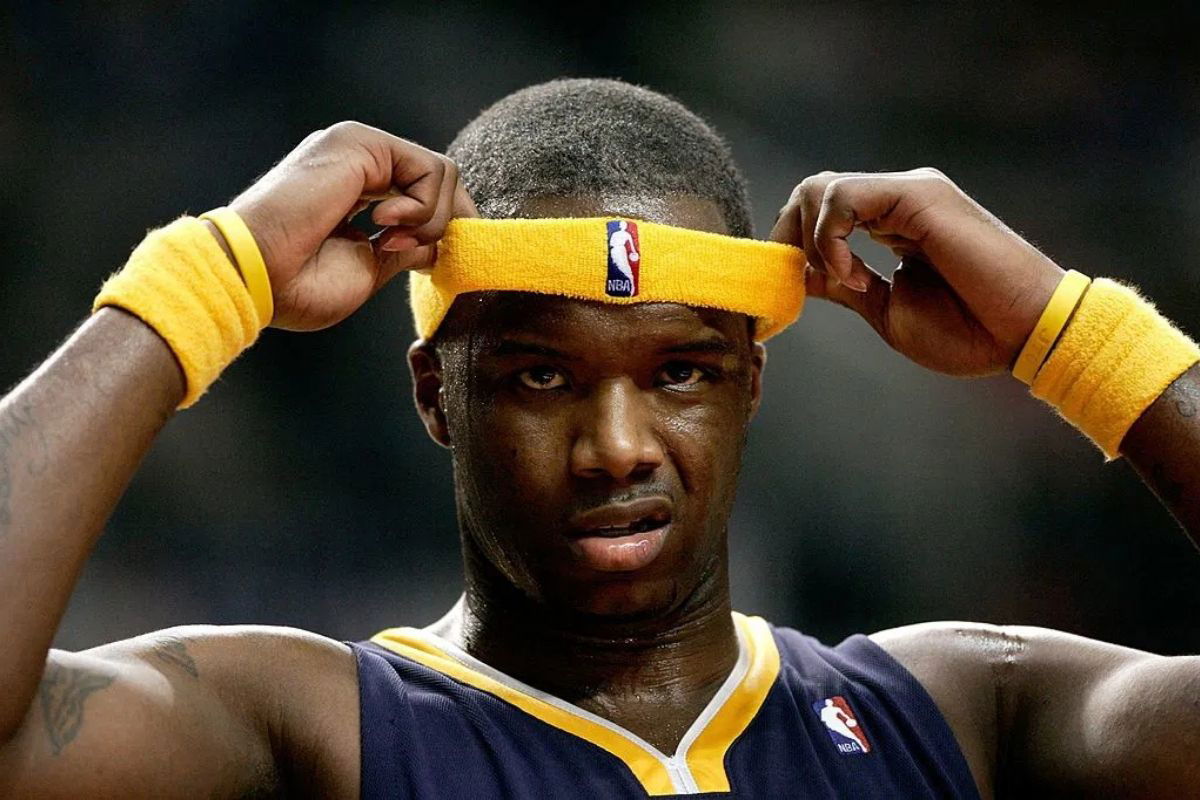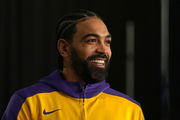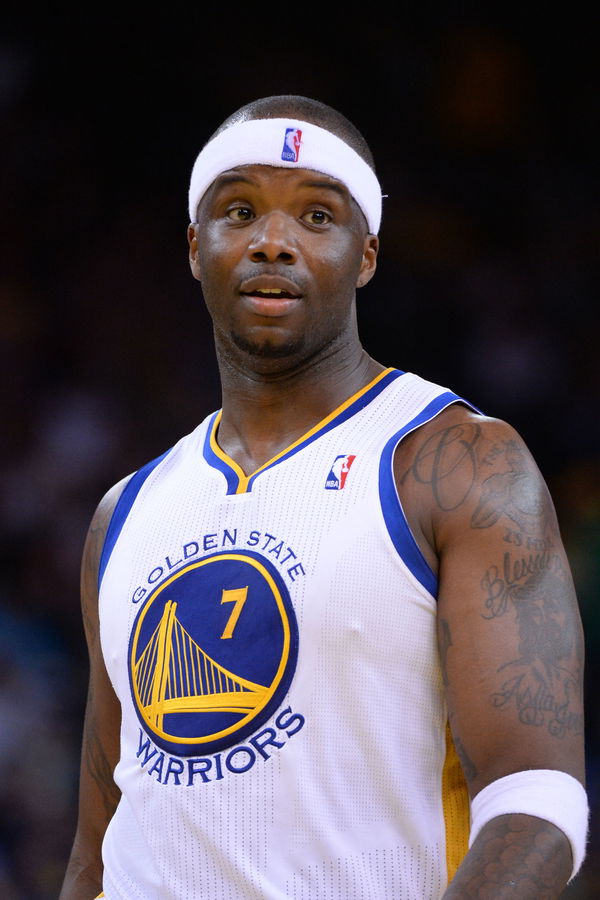
Getty
PORTLAND, OR – NOVEMBER 28: Jermaine O’Neal #7 of the Indiana Pacers adjusts his headband against the Portland Trail Blazers on November 28, 2006 at the Rose Garden in Portland, Oregon. NOTE TO USER: User expressly acknowledges and agrees that, by downloading and or using this Photograph, user is consenting to the terms and conditions of the Getty Images License Agreement. (Photo by Jonathan Ferrey/Getty Images)

Getty
PORTLAND, OR – NOVEMBER 28: Jermaine O’Neal #7 of the Indiana Pacers adjusts his headband against the Portland Trail Blazers on November 28, 2006 at the Rose Garden in Portland, Oregon. NOTE TO USER: User expressly acknowledges and agrees that, by downloading and or using this Photograph, user is consenting to the terms and conditions of the Getty Images License Agreement. (Photo by Jonathan Ferrey/Getty Images)
In NBA history, there are moments that are beyond any scoreboard, with episodes so emotionally charged that they shape legacies more than titles ever could. For Jermaine O’Neal, the Malice at the Palace was one of those moments that will stay with him till the end. While the box score from that fateful November night in 2004 is long forgotten, the emotions it ignited are not taking the name of fading. And for O’Neal, that memory isn’t defined by chaos but by faith that one anchored in an unwavering sense of loyalty.
Watch What’s Trending Now!
His role in the infamous brawl has long been reduced to grainy footage and broad narratives that were built back in the time with little nuance afforded to his perspective, which he provides after almost 21 years. Lost beneath the pile of suspensions and legal charges was a claim that O’Neill has repeated for years: that his actions were rooted in protection, not aggression. His sole goal was to protect himself, and he wasn’t simply reacting to violence around him.
He believed he was shielding a teammate, and nearly two decades later, that claim has found vindication not through media headlines but through a courtroom and, most recently, his own words in a podcast. O’Neal talked about a time on the Out the Mud Podcast that never made it into the news, and it was solely going after a specific location where his teammate, Anthony Johnson, was weak. “People think I just ran in and just hitting me. That wasn’t the case,” he said before diving deep into the story.
ADVERTISEMENT
“I saw him… he’s on the ground. The little guy’s on top of him, and there are people standing around him.” O’Neal’s reaction was instinctual, “I see Anthony Johnson trying to get up and I run over there and I slip, but I hid him because now he’s on he’s trying to bring harm to my my my homeboy my teammate here’s the thing that’s that really that really bugged me out.” even if it didn’t come without consequence. What followed was a legal battle — one that ended in federal court, where a judge ruled in his favor. “I had every right to get that man off your back, to do what I did.”
While his ban was originally imposed at 25 games, an arbitrator lowered it to 15, citing the chaotic circumstances of the incident and O’Neal’s right to self-defense. It was a quiet win, hidden under the bigger stories of shame and failure. But for O’Neal, it was everything—a moment when the system recognized his humanity, even if the public never did.
ADVERTISEMENT
“The Timing Wasn’t Right”: Jermaine O’Neal’s victory that never made headlines
The courtroom vindication came with no press conference, no front-page celebration — just silence. And for Jermaine, that silence said everything. “Nobody said nothing, right? And that was fine. I understood the timing wasn’t right,” he told the podcast. O’Neal’s feeling of not being heard affected not just how he thought about the event, but also how he thought about his whole career in the years that followed.
His fallout from the Malice at the Palace wasn’t just legal, it was emotional. The Pacers, who had been title contenders in 2004, were gutted by 146 combined games of suspension. O’Neal, Stephen Jackson, and Ron Artest (now Metta Sandiford-Artest) took the most of it. After the brawl, O’Neal’s chances of winning the championship and getting into the Hall of Fame took a blow. Even though he was a six-time All-Star, the Most Improved Player, and Indiana’s all-time leader in blocks, the event stayed in people’s minds longer than his awards.
ADVERTISEMENT
O’Neal’s relationship with Artest fractured soon after. When Artest requested a trade during the 2005-06 season, O’Neal was stunned. “That felt like betrayal,” he once said. They didn’t talk for 14 years, but they did meet again at the BIG3 league in 2018. O’Neal finally grasped Artest’s mental health problems there, which changed how he thought about what happened in 2004. “He’s a loyal friend,” Artest later told Untold: Malice at the Palace, crediting O’Neal by putting his body on the line for him.
Top Stories
Lakers’ Gabe Vincent Dishes on LeBron James, Luka Doncic’s Sacrifices, Role on the Team and More (Exclusive)

Arrest For Shaquille O’Neal’s Stolen Range Rover Made But More Bad News Awaits

Calls Mount Against NBA Refs After Stephen Curry Wrongfully Punished vs Timberwolves

Caitlin Clark, JuJu Watkins Announce Injury Update After Months of Battle

Lakers Champ Isaiah Rider Breaks Silence On Arrest For Order Violation


USA Today via Reuters
Apr 6, 2014; Oakland, CA, USA; Golden State Warriors center Jermaine O’Neal (7) looks on against the Utah Jazz during the third quarter at Oracle Arena. The Warriors defeated the Jazz 130-102. Mandatory Credit: Kyle Terada-USA TODAY Sports
That loyalty was silent, unrewarded, and often misinterpreted, and is the foundation of O’Neal’s “untold victory.” While others viewed that night as his downfall, he sees it as the moment he stood up for the right when it mattered the most. “I had every right,” he emphasized. And though history may never fully revise its verdict, ex-Pacers star Jermaine O’Neal knows exactly what he was fighting for.
ADVERTISEMENT
ADVERTISEMENT
ADVERTISEMENT
ADVERTISEMENT

